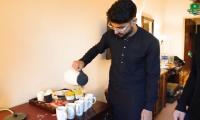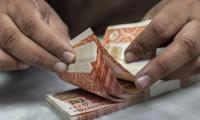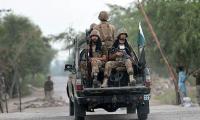Approximately 88 percent of the wealth created last year went to the one percent rich as opposed to half the world’s poor (3.7 billion people), who saw no increase in their income, says an Oxfam report which was released before the World Economic Forum’s annual meeting. This is an economy for one percent at the cost of 99 percent of population, the report further laments. Where is the world of capitalism heading?
Only 62 billionaires are worth the total assets of the poor half of the world. Billionaires earned $762 billion last year, an amount that is enough to overcome extreme poverty seven times over. If one and a half percent tax is levied on the rich, it can help every child go to school all over the world. The Oxfam report expresses serious doubts about the achievement of the goals set by Sustainable Development agenda by 2030. At the current rates of change, it will take 217 years to close the gap in pay and employment opportunities between women and men.
It is in fact against the exploitative and differentiating nature of capitalism to address the plight of the people. Capitalism thrives on the labour of others for the ever-increasing concentration of capital. Mark Goldring, chief executive of Oxfam GB, says that the statistics reveal that “something is very wrong with the global economy”. According to Oxfam, the reasons behind the widening inequality gap are the erosion of worker’s rights, stagnation of living wages, cost-cutting and businesses’ influence on policy decisions.
Keeping the given socio-economic framework, Oxfam calls for ensuring that the wealthy pay their fair share of tax through higher taxes and a crackdown on tax avoidance, and increase spending on public services such as healthcare and education. For this report, Oxfam surveyed over 70,000 people in 10 countries, nearly two-thirds of who said that the gap between rich and poor should be urgently addressed. “People are ready for change...they want to see workers paid a living wage; they want corporations and the super-rich to pay more tax; they want women workers to enjoy the same rights as men; they want a limit on the power and the wealth which sits in the hands of so few. They want action”.
But all that is not possible without the organised class struggle of wage workers of all varieties. It is a ‘world system’ that works only to the advantage of the privileged few who are free to exploit both human and natural resources to maximise their un-earned profits. Capitalism is based primarily on the exploitation of the surplus labour time of the workers to expropriate more and more surplus value, while reducing the necessary labour time of the workers to hardly meet their livelihood through relatively diminishing wages.
The conditions of the working-class people in Pakistan are even worse. According to a newspaper report, Pakistan’s first ever official report on multidimensional poverty details our official Multidimensional Poverty Index (MPI). The report has been compiled with technical support from UNDP Pakistan and the Oxford Poverty and Human Development Initiative (OPHI), University of Oxford. According to the report, nearly 39 percent of Pakistanis live in multidimensional poverty, with the highest rates of poverty in Fata and Balochistan.
Pakistan’s MPI showed a strong decline from 2004 to 2015, with national poverty rates falling from 55 percent to 39 percent. However, progress across different regions of Pakistan is uneven. Poverty in urban areas is 9.3 percent as compared to 54.6 percent in rural areas. Disparities also exist across provinces. The report found that over two-thirds of people in Fata (73 percent) and Balochistan (71 percent) live in multidimensional poverty. Poverty in Khyber Pakhtunkhwa stands at 49 percent, Gilgit-Baltistan and Sindh at 43 percent, Punjab at 31 percent and Azad Jammu and Kashmir at 25 percent.
The report further says that deprivation in education contributes the largest share – 43 percent – to the MPI, followed by living standards which contributes nearly 32 percent and health which contributes 26 percent. These findings further confirm that social indicators are very weak in Pakistan, even where economic indicators appear healthy. The report also found that the decrease in multidimensional poverty was slowest in Balochistan; poverty levels have actually increased in several districts in Balochistan and Sindh during the past decade. The level and composition of multidimensional poverty for each of Pakistan’s 114 districts are also covered in this report.
It must be noted that, according to economist Dr Pervez Tahir, “the poverty line drawn by the government since 2013 at Rs3,030 a month was found to be less than a dollar a day – well below the internationally recommended bottom line of two dollars a day”. Since the Consumer Price Index (CPI) is variably computed for different levels of income, “its lowest income quintile is Rs8,000 and below with a base period of 2007-08”. While the official wage is set at Rs15000 a month, workers unions demand a living wage equal to one ‘tola’ of gold or over Rs50,000 to cover most essentials of livelihood.
In a national security state like Pakistan, which is dominated by the capitalist and landed elites, the plight of working-class people is worse than it is in other middle-income countries. Most labour is employed in the agriculture and informal sectors, where there is no regulation and where no minimum wage is given in a relationship of extra-economic coercion. In the formal sectors, unions are either not allowed or have been rendered ineffective. Political parties whether religious, conservative or liberal are all tuned in to neo-liberal economic agendas that suit the parasitic elites and keep an over-burdening super-structure on a fragile and unsustainable economic base. No party has any kind of pro-people development strategy that will take our great mass of impoverished people out of poverty. Our political parties fight on trivial issues to misguide the people, who are being further divided on sectarian or ethnic lines.
Poverty, unemployment, illiteracy, pollution, lack of healthcare and the terrible living conditions that are faced by the majority of our people should be the foremost priority of a national development agenda. But, no political party is serious about these issues. Therefore, the peoples of this country and its progressive intelligentsia should come forward for a class-proportionate representation at all levels of elected bodies, more taxes for the rich, more spending on the poor, higher budgetary allocations for education and health, equal opportunities and wages for women, security for children and social security for all. Let it be an economy for the 99 percent – not the one percent.
The writer is a senior journalist.
Email: imtiaz.safma@gmail.com
Twitter: @ImtiazAlamSAFMA
An aeroplane of the national flag carrier of Pakistan is seen in this file photo. — AFPWhile Pakistan considers...
Representational image of a graph depicting various variables. — APP/FileInitiated by the centre and fiercely...
In this picture taken on April 16, 2023, people throng a market area during shopping in Lahore. — AFPOne of the...
Honour crimes also target men. In Sikandar Ali Lashari vs The State, SHC upheld conviction passed by ATC for honour...
If Sindh earmarks Rs20 million per police station, it will cost only Rs10 billion to make them effective first...
A complex and difficult policy environment seems to be highlighted by US’s recent application of sanctions on...







